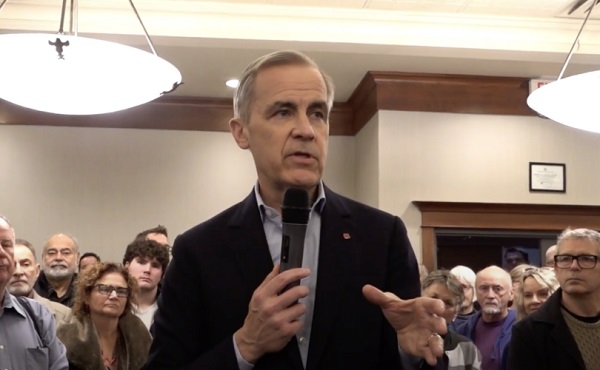National
Daughter of Canadian PM Mark Carney uses ‘they/them’ pronouns

From LifeSiteNews
Canadian Prime Minister Mark Carney has a daughter who identifies as “non-binary” and uses “they/them” pronouns.
The Daily Mail first reported these details on March 10:
Carney’s other daughter Sasha, 24, who graduated cum laude from Yale University with a degree in English and Gender Studies, uses they/them pronouns, according to their social media profiles. They previously went by the name Sophia. Sasha Carney, who currently works as a freelance writer and reviewer in Brooklyn, New York, has previously posted about their mental health struggles online.
Sasha’s Facebook profile, which was publicly accessible at time of publication, shows that she self-identified as “non-binary” in 2018:

Many of Carney’s publicly stated views are avowedly leftist; one of her profile pictures identifies her as a supporter of socialist Bernie Sanders. In 2019, she made a Facebook post stating that “Yale is an institution which has promoted and legitimized eugenics, global warfare, genocidal policies, the racialized carceral state, and the hyper-privileging of white voices in academia. In the face of this, it is crucial that we invest time, energy, thought, resources, and love into ethnicity, race, and migration studies, which looks at the world, and Yale itself, through a critical anti-racist and anticolonial lens.”
Juno News, formerly known as True North, broke additional details earlier today, publishing excerpts of an essay written by Sasha Carney in an alternative magazine called Authenticity in April 2020 titled Mumsnet, and Transmasculine Childhood. As reporters Cosmin Dzurdzsa and Alex Zoltan noted, the essay reveals that “Mark Carney sent [his] daughter to [the] discredited U.K. Tavistock Transgender Clinic.” The published excerpt reads:
In 2013, shortly after I chopped off all my hair into a deeply regrettable floppy Justin Bieber cut, I moved to London, the land of Enid Blyton murder mysteries. A block from my new house was the Tavistock & Portman NHS Foundation Trust, an imposing grey building which contained the country’s only child and adolescent ‘gender identity clinic.’
I watched as my friend, after a year of weekly appointments trying desperately to get an official diagnosis of gender dysphoria, was denied the diagnosis, and with it any hope of top surgery because they sometimes wore skirts. I watched organisations with names like ‘Transgender Trend’ refer to trans Tavistock patients as ‘experimental subjects’ who didn’t know what was best for them. I watched as my school’s former principal told a national news outlet that trans students like me and many of my close friends were cis women who were only coming out to ’cause turbulence’ and ‘adhere to anything a bit radical.’ I watched all this happen, and I quietly stopped wearing underwire bras, and wore baggier clothes, and I felt a fierce surge of jealousy every time I walked into the Tavistock for therapy and saw patients turn left, towards the medical spaces I didn’t feel ‘trans enough’ to enter.
The essay has since been scrubbed from the internet.
In 2022, it was announced that Tavistock was being shut down, with over 1,000 families expected to join a massive lawsuit over the damage done to their children due to the “treatment” they received at the gender clinic. Last year, the U.K. National Health Service announced that it would stop prescribing puberty blockers to minors entirely. Juno News also reported that Sasha has expressed her support, in writing, for “puberty blockers” for children.
It is difficult to overstate the potential political impact of this story. Last year, Danielle Smith’s government in Alberta banned sex change surgeries and puberty blockers for minors; in a press conference in February 2024, Smith specifically cited the Tavistock clinic as a motivation behind her legislation.
“We have been tracking what’s been happening internationally – in Great Britain with the Tavistock Clinic, in Finland, in Norway, in Sweden – and we’ve seen that there has been a substantial change in the approach to dealing with these issues,” Smith observed.
The fact that the prime minister’s daughter went to Tavistock clinic is certainly an indication of his views on such legislation, and an indication that his commitment to the transgender agenda will likely be every bit as fervent as his predecessor’s.
National
Women and girls beauty pageant urges dismissal of transgender human rights complaint

There has not been a human rights case in Canada that has dealt with whether children’s emotional, mental, and physical safety should take precedence over a transwoman’s desire to access a female changeroom.
The Justice Centre for Constitutional Freedoms announces that Canada Galaxy Pageants (CGP), a beauty competition based in Mississauga, Ontario, continues to face a drawn-out human rights complaint filed in 2019 by Ms. Jessica Yaniv (also known as Ms. Jessica Simpson). Despite repeated delays, missed deadlines, and inadequate filings by Ms. Simpson, the Human Rights Tribunal of Ontario (Tribunal) has allowed the case to continue—imposing years of uncertainty, stress, and reputational harm on pageant activities and its organizers.
On July 8, 2025, lawyers provided by the Justice Centre wrote to the Tribunal requesting that the complaint against the pageant be dismissed.
The conflict began in 2019, when Ms. Jessica Simpson (identifying at the time as Ms. Jessica Yaniv) was asked whether she had fully transitioned to female prior to competing in a CGP beauty pageant. Ms. Simpson refused to answer and filed a complaint with the Tribunal, seeking $10,000 in damages for “injury to dignity and feelings” and a ruling against the pageant that it must allow biological males to participate alongside biological females and young girls.
CPG pageants are private events that include female competitors as young as six years old, and require participants to change together backstage.
The pageant has a policy of accommodating fully transitioned transgender women, but has expressed safety and privacy concerns about allowing individuals with intact male genitals to access these female-only spaces.
There has not been a human rights case in Canada that has dealt with whether children’s emotional, mental, and physical safety should take precedence over a transwoman’s desire to access a female changeroom.
In January 2025, the Tribunal directed both parties to file hearing materials. While the pageant complied, submitting nine witness statements, including from concerned parents, Ms. Simpson repeatedly failed to meet deadlines and produced inadequate submissions. Ms. Simpson was nevertheless granted multiple extensions, but still failed to submit a proper case summary or witness list beyond naming her own mother.
The Tribunal has not yet indicated whether it will proceed to a hearing or will finally dismiss the claim.
Constitutional lawyer Allison Pejovic stated, “This beauty pageant has already made reasonable accommodations for fully transitioned transgender females without male genitals.”
“It is imperative that biological women and girls have safe, secure, female-only places where they won’t have to worry about seeing male genitals, or about having individuals with male genitals looking at them,” Ms. Pejovic continued. “Little girls should not be exposed to male genitals. Period.”
Canada Galaxy Pageants continues to express gratitude for the legal support it has received from the Justice Centre.
The Tribunal is expected to decide in the coming weeks whether it will finally dismiss the complaint or extend further leniency to Ms. Simpson.
National
How Long Will Mark Carney’s Post-Election Honeymoon Last? – Michelle Rempel Garner

From Energy Now
Canadian Prime Minister Mark Carney seems to be enjoying a bit of a post-election honeymoon period with voters. This is a normal phenomenon in Canadian politics – our electorate tends to give new leaders the benefit of the doubt for a time after their election.
So the obvious question that arises in this circumstance is, how long will it last?
I’ve had a few people ask me to speculate about that over the last few weeks. It’s not an entirely straightforward question to answer, because external factors often need to be considered. However, leaders have a lot of control too, and on that front, questions linger about Mark Carney’s long-term political acumen. So let’s start there.
Having now watched the man in action for a hot minute, there seems to be some legs to the lingering perception that, as a political neophyte, Mr. Carney struggles to identify and address political challenges. In the over 100 days that he’s now been in office, he’s laid down some proof points on this front.
For starters, Mr. Carney seems to not fully grasp that his post-election honeymoon is unfolding in a starkly different political landscape than that of his predecessor in 2015. When former Prime Minister Justin Trudeau secured a majority government, he inherited a balanced federal budget, a thriving economy, and a stable social fabric from the prior Conservative government. These favorable conditions gave Trudeau the time and flexibility to advance his political agenda. By contrast, Canadians today are grappling with crises in affordability, employment, and crime – issues that were virtually non-existent in 2015. As a result, public patience with a new political leader may wear thin much more quickly now than it did a decade ago.
So in that, Carney doesn’t have much time to make material progress on longstanding irritants like crime and affordability, but to date, he really hasn’t. In fact, he hasn’t even dedicated much space in any of his daily communications to empathizing with the plight of the everyday Canadian, eschewing concern for bread and butter issues for colder corporate speak. So if predictions about a further economic downturn in the fall ring true, he may not have the longer term political runway Justin Trudeau once had with the voting public, which doesn’t bode well for his long term favourables.
Carney’s apparent unease with retail politics won’t help him on that front, either. For example, at the Calgary Stampede, while on the same circuit, I noticed him spending the bulk of his limited time at events – even swish cocktail receptions – visibly eyeing the exit, surrounded by an entourage of fartcatchers whose numbers would have made even Trudeau blush. Unlike Trudeau, whose personal charisma secured three election victories despite scandals, Carney struggles to connect with a crowd. This political weakness may prove fatal to his prospects for an extended honeymoon, even with the Liberal brand providing cover.
It’s also too early to tell if Carney has anyone in his inner circle capable of grasping these concepts. That said, leaders typically don’t cocoon themselves away from people who will give blunt political assessments until the very end of their tenures when their political ends are clear to everyone but them. Nonetheless, Carney seems to have done exactly that, and compounded the problem of his lack of political acumen, by choosing close advisors who have little retail political experience themselves. While some have lauded this lack of political experience as a good thing, not having people around the daily table or group chat who can interject salient points about how policy decisions will impact the lives of day to day Canadians probably won’t help Carney slow the loss of his post-election shine.
Further proof to this point are the post-election grumblings that have emerged from the Liberal caucus. Unlike Trudeau, who started his premiership with an overwhelming majority of his caucus having been freshly elected, Carney has a significant number of old hands in his caucus who carry a decade of internal drama, inflated sense of worth, and personal grievances amongst them. As a political neophyte, Carney not only has to prove to the Canadian public that he has the capacity to understand their plight, he also has to do the same for his caucus, whose support he will uniformly need to pass legislation in a minority Parliament.
To date, Carney has not been entirely successful on that front. In crafting his cabinet, he promoted weak caucus members into key portfolios like immigration, kept loose cannons in places where they can cause a lot of political damage (i.e. Steven Guilbeaut in Heritage), unceremoniously dumped mavericks who possess big social media reach without giving them a task to keep them occupied, and passed over senior members of the caucus who felt they should either keep their jobs or have earned a promotion after carrying water for a decade. Underestimating the ability of a discontented caucus to derail a leader’s political agenda – either by throwing a wrench into the gears of Parliament, leaking internal drama to media, or underperformance – is something that Carney doesn’t seem to fully grasp. Said differently, Carney’s (in)ability to manage his caucus will have an impact on how long the shine stays on him.
Mark Carney’s honeymoon as a public figure also hinges upon his (arguably hilarious) assumption that the federal public service operates in the same way that private sector businesses do. Take for example, a recent (and hamfistedly) leaked headline, proactively warning senior public servants that he might fire them. In the corporate world, where bonuses and promotions are tied to results, such conditions are standard (and in most cases, entirely reasonable). Yet, after a decade of Liberal government expansion and lax enforcement of performance standards, some bureaucrats have grown accustomed to and protective of Liberal slipshod operating standards. Carney may not yet understand that many of these folks will happily leak sensitive information or sabotage policy reforms to preserve their status quo, and that both elegance and political will is required to enact change within the Liberal’s bloated government.
On that front, Mr. Carney has already gained a reputation for being dismissive and irritable with various players in the political arena. While this quick-tempered demeanor may have remained understated during his relatively brief ascent to the Prime Minister’s office, continued impatience could soon become a prominent issue for both him and his party. Whether dismissing reporters or publicly slighting senior cabinet members, if Carney sustains this type of arrogance and irritability he won’t be long for the political world. Without humility, good humor, patience, and resilience he won’t be able to convince voters, the media, the bureaucracy, and industry to support his governing agenda.
But perhaps the most important factor in judging how long Mr. Carney’s honeymoon will last is that to date he has shown a striking indifference to nuclear-grade social policy files like justice, immigration, and public safety. His appointment of underperforming ministers to these critical portfolios and the absence of a single government justice bill in Parliament’s spring session – despite crime being a major voter concern – is a big problem. Carney himself rarely addresses these issues – likely due to a lack of knowledge and care – leaving them to the weakest members of his team. None of this points to long term political success for Carney.
So Mr. Carney needs to understand that Canadians are not sterile, esoteric units to be traded in a Bay Street transaction. They are real people living real lives, with real concerns that he signed up to address. He also needs to understand that politics (read, the ability to connect with one’s constituents and deliver for them) isn’t an avocation – it’s a learned skill of which he is very much still a novice practitioner.
Honeymoon or not, these laws of political gravity that Mr. Carney can’t avoid for long, particularly with an effective opposition litigating his government’s failures.
In that, I think the better question is not if Mark Carney can escape that political gravity well, but whether he’ll stick around once his ship inevitably gets sucked into it.
Only time – and the country’s fortunes under his premiership – will tell.
-

 Automotive2 days ago
Automotive2 days agoAmerica’s EV Industry Must Now Compete On A Level Playing Field
-

 Business2 days ago
Business2 days ago‘Experts’ Warned Free Markets Would Ruin Argentina — Looks Like They Were Dead Wrong
-

 Business2 days ago
Business2 days agoCarney government should recognize that private sector drives Canada’s economy
-

 Alberta1 day ago
Alberta1 day agoAlberta school boards required to meet new standards for school library materials with regard to sexual content
-

 International2 days ago
International2 days agoSecret Service suspends six agents nearly a year after Trump assassination attempt
-

 Bruce Dowbiggin2 days ago
Bruce Dowbiggin2 days agoThe Covid 19 Disaster: When Do We Get The Apologies?
-

 Alberta1 day ago
Alberta1 day agoFourteen regional advisory councils will shape health care planning and delivery in Alberta
-

 Environment24 hours ago
Environment24 hours agoEPA releases report on chemtrails, climate manipulation







